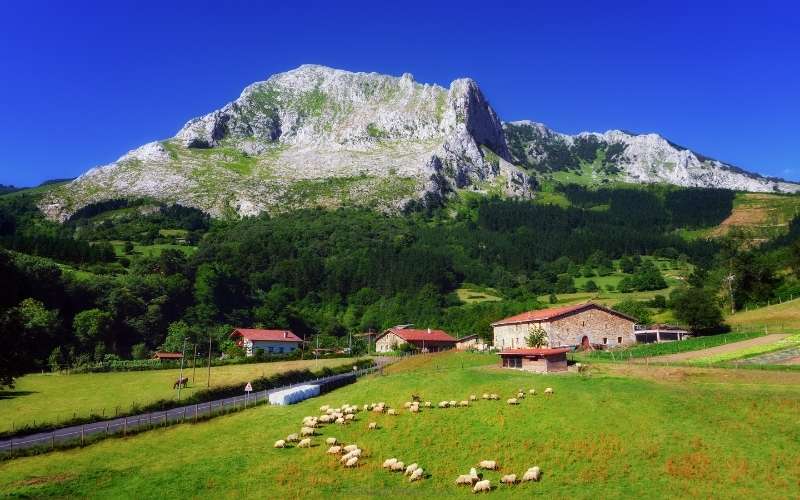Whilst the only official language of Spain may be Castilian (standard) Spanish, there are also several other co official languages that are spoken in various different regions of Spain.
In this article, we are going to cover the various languages in Spain and just how they came to be.

Apart from Spanish, Spain has eight other languages that are spoken in its territory, these languages are:
- Catalan: spoken in Catalonia/Catalunya
- Galician: spoken in Galicia.
- Basque: (Euskara) spoken in Basque Region
- Asturian: spoken in Asturias.
- Aranese: spoken in the Val D’aran region.
- Valencian: spoken in the Valencian Community
- Aragonese: spoken in Aragon – mainly in the valleys of the Aragon River, Sobrarbe and Ribagorza.
- Galician-Portuguese: spoken in the areas surrounding the Galicia-Portugal border
What languages are spoken in Spain other than Spanish?
Of these languages, only Basque, Galician, Aragonese, Valencian, and Catalan are the languages of Spain with co official status.
So, Spain has one official language and an impressive, five co-official languages.
1. Basque

Basque (Euskara) is a language that is spoken in the northern part of Spain and in the southwestern part of France and is concentrated mainly in the western part of the Pyrenees. It is the oldest language in Europe.
Based in a mild and damp climate, and surrounded by hills, the Basque country was rich in iron ore, which helped the Basque country become industrially strong – mainly when it came down to shipbuilding.
Due to this the Basques became efficient sailors and is one of the major reasons why the Basques played a key role in the colonization of the Americas.
Due to inheritance law in the Basque country, houses (known as Caserios) were passed down through the family, promoting a very strong sense of family and kinship among the occupants of the dwelling.
Whilst a large population of Spaniards now live in cities, in the Basque country, the majority still live in rural areas but this is changing due to immigration from the Americas and from France.
Most Basque language speakers also use French or Spanish and the majority of its remaining speakers live in the remote inland mountain areas.
2. Galician

The Galician language is a Romance language that is spoken in the region of Spain called Galicia, located in the northwest of the country.
Originally, Galician started off as a dialect of Portuguese, due to its geographic location as it is located to the north of Portugal, (in the northwest corner of Spain) but over the years evolved until it splintered off to form its own language, and then later got further influenced by Castilian Spanish; the predominant language in Spain.
Galician was originally dominant in the Castile area of Spain, which is where Castilian (standard) Spanish originated.
However, it lost popularity around the 1400s and was then Castilian not only became the conventional language in Castile but also became the official language of Galicia too.
Galician originated from Vulgar Latin, and this continues into modern-day Galician, with a few words of Germanic and Celtic origin being incorporated, alongside a lot of nouns that are borrowed from Andalusian Arabic.
What about Galician-Portuguese?
As you’ll read below, Galician-Portuguese is not an official language of Spain but Galician and Portuguese languages are considered mutually intelligible .
This means speakers of one language can understand the related language.
3. Aragonese

Another language that is spoken mainly in the Pyrenees, in Spain is Aragonese.
Aragonese is a Romance language that is mostly spoken in the valleys of Aragon in the Pyrenees and is spoken by around ten-to-twelve thousand speakers, actively, and thirty-to-fifty thousand speakers passively.
Since the new languages act, decreed in 2011, Aragonese is listed as the native, original and historic language of Aragon.
This language can be traced back to the high middle ages when it started in the Ebro basin and then proceeded to spread to the Pyrenees and other areas where Basque was being spoken.
Nowadays, Aragonese is spoken in several cities and towns, such as Echo, Campo, and Plan – among many others. It is also spoken as a secondary language in many other cities and towns.
4. Valencian

The Valencian community in Spain, located on the eastern coast of Spain, also has its own language that goes by the name Valencian, or as it is known in Spain “Valenciano.”
Originally the language was similar to Catalan, but Valencia’s status of autonomy act of 1982 recognized it as its own language and the regional language of Valencia.
Within this language, there are several different dialects: Alicante’s Valencian, Southern Valencian, Central Valencian (Apitxat), Northern Valencian, and Transitional Valencian.
Valencian is considered as one of the Ibero-Romance and Gallo-Romance languages, and due to this, it bears a similarity to standard Castilian Spanish.
Over one-third of the habitants of Valencia speak Valencian as their mother tongue, whilst just over half of all Valencians are able to speak it.
However, it can be noted that in bigger towns, they tend to speak more standard Spanish when outside, moving Valencian to either smaller towns or to just being spoken within the household.
Although Valencian is very similar in written form to its neighbor language of Catalan, when it is spoken, it is much more similar to Castilian Spanish.
Valencian is also taught in the public school system, at every single level – from preschool to high school.
This means that sixty percent of classes are given in Valencian, thirty percent in standard Castilian Spanish, and ten percent in English.
5. Catalan

The Catalan language is probably one of the most well-known languages that come from Spain aside from the standard Castilian Spanish, due to it being spoken in one of the Spanish cities that attracts the most tourists; Barcelona.
Catalan is the language that is spoken mainly in Catalonia, Valencia, and also in the Balearic Islands, and like most of the languages spoken in Spain, it has its origins based in Latin and so, is considered a romance language.
Outside of Spain, Catalan is also spoken in Italy, France, and Andorra – of the latter is the official language.
There are two main dialect groups in modern-day Catalan, with the western dialect being west Catalan` and Valencian and the eastern group being spoken in the Balearic islands, Roussilliannais and in Alghero.
Whilst Catalan looks similar to both French and Spanish, it is still distinct from the both of them.
It differs from Spanish in terms of pronunciations, sounds and diphthongs – choosing to use pronunciations more similar to both English and French when it comes to sounds such as “j”, for example.
Although Catalan usage went into decline after the union of the Aragonese and Castilian crowns in the 15th century, it was later revived and used as the principal language of politics and education, alongside everyday usage, in Catalonia.
How did Castilian Spanish become the primary language?
With the marriage of Ferdinand and Isabella in the 15th century, the Aragonese and Castilian crowns – two of the largest territories with the Iberian peninsula – and “Spanish” were created with the intention to bring about social, political and cultural reform within the country.
Whilst Castilian Spanish became more common, the other language on the peninsular were still in use in their respective locations.
When Francisco Franco came into power after the Spanish civil war of 1936 to 1939, his government made moves to suppress all languages spoken in Spain that weren’t standard Castilian Spanish.
During Franco’s reign, in his goal to promote nationalism, he tried to ensure that everything in his country was in Castilian Spanish, all films had to either be in Spanish or dubbed into Spanish – this included films made and produced in Spain in any of its other languages.
Alongside this, it was forbidden that babies were given names that weren’t Catholic Castilian Spanish names.
This meant names that were traditional and special to Catalans, Basques, Galicians were made illegal.
Why are there so many dialects in Spain?
It was also during the first part of Franco’s reign that it was made illegal to speak any other languages other than Castilian Spanish, outside of the home, as one of his policies dictated Spanish as the only language of Spain, and that all of the other languages were now just considered dialects.
The reasoning behind the other regional languages being declared as “dialects” was due to the political discourse of the time stating that they were not as developed as the Standard Castilian Spanish, and so, were not fit for use; and were only good enough to be used for the isolated communities in which they existed.
Even though these policies and practices became less and less strict over the passage of time, the effect that they had on the non-dominant languages of the country had a lasting effect on the language and upon their communities.
Final Thoughts
In conclusion, alongside the official language of Castilian Spanish, Spain has various other languages, spoken in the many different provinces that contribute to it having a total of five co-languages with official status.
Whilst a majority of these languages have their roots in Latin, each one has adapted and evolved to its geographic location and has helped the people of the area build kinship among them and thereby further developed their provincial sense of culture.
Language is an integral part of the culture, and the vast range of languages spoken in Spain help contribute not only to its beauty but also to its cultural richness.
Each and every part of Spain is rich and full of culture and adding different Spanish languages on top of this only works to make the country more breathtaking and intriguing.
So what are you waiting for? Which of the many languages that Spain speaks do you want to learn first?
